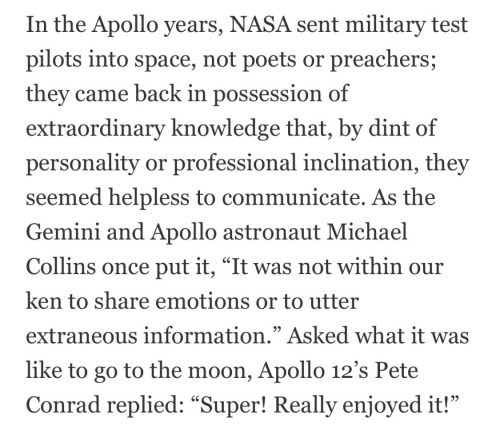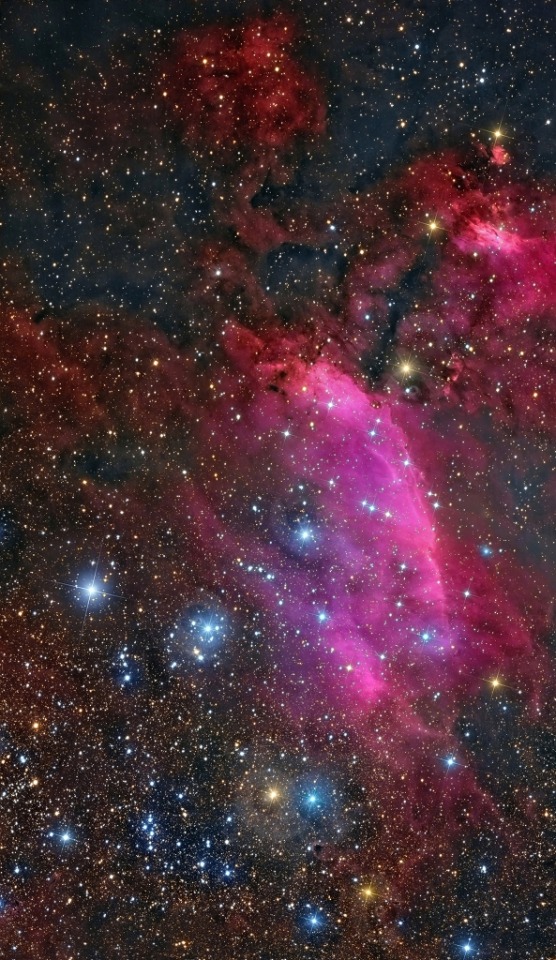Titan's High-level Haze Taken By Cassini On October 12, 2010.

Titan's high-level haze taken by Cassini on October 12, 2010.
Image credit: NASA/JPL/Space Science Institute. Edited by J. Major.
More Posts from Ad-astra-affecte-spe and Others
Don't talk to me right now I'm thinking of the new Jupiter photos and Vincent Van Gogh:








Corona Australis
Nebula is mostly hydrogen gas, and a small amount of metals (elements above helium) which tend to be covered as "Dust", but it's the dust that best reflect the light of the stars, and as the largest and most energetic of them are blue, you get these areas of blue haze. Hydrogen more often glows red when bombarded by UV light, the two colours together quite magical.

The area has a number of NGC objects 6726,6727,6729 but born of the same huge molecular cloud.
Our Milky Way has many such areas full of star birth, and as blue giants are not long lived, supernova and star death too.

2023 September 28
The Deep Lagoon Image Credit & Copyright: Josep Drudis, Christian Sasse
Explanation: Ridges of glowing interstellar gas and dark dust clouds inhabit the turbulent, cosmic depths of the Lagoon Nebula. Also known as M8, The bright star forming region is about 5,000 light-years distant. It makes for a popular stop on telescopic tours of the constellation Sagittarius toward the center of our Milky Way Galaxy. Dominated by the telltale red emission of ionized hydrogen atoms recombining with stripped electrons, this deep telescopic view of the Lagoon’s central reaches is about 40 light-years across. The bright hourglass shape near the center of the frame is gas ionized and sculpted by energetic radiation and extreme stellar winds from a massive young star.
∞ Source: apod.nasa.gov/apod/ap230928.html


Messier 45: The Pleiades
Nick Fritz on Instagram



Mars painting by Herb Herrick for an article about terraforming in World Book Science Annual 1975. Consultant: Carl Sagan. The first painting (top) is followed by two clear plastic overlays of the skies and rain and finally plant life.


Galaxy Collisions Arp 140,143 © Hubble

The four giant planets of our Solar System, as seen by NASA's James Webb Telescope.
-
 thegurlfromipanemaa reblogged this · 1 year ago
thegurlfromipanemaa reblogged this · 1 year ago -
 inthedreamofaland liked this · 1 year ago
inthedreamofaland liked this · 1 year ago -
 osveta reblogged this · 1 year ago
osveta reblogged this · 1 year ago -
 osveta liked this · 1 year ago
osveta liked this · 1 year ago -
 ara-m1nta reblogged this · 1 year ago
ara-m1nta reblogged this · 1 year ago -
 ara-m1nta liked this · 1 year ago
ara-m1nta liked this · 1 year ago -
 allergic-to-chocolate liked this · 1 year ago
allergic-to-chocolate liked this · 1 year ago -
 werewolff liked this · 1 year ago
werewolff liked this · 1 year ago -
 ninaizantina reblogged this · 1 year ago
ninaizantina reblogged this · 1 year ago -
 ninaizantina liked this · 1 year ago
ninaizantina liked this · 1 year ago -
 metalzoic liked this · 1 year ago
metalzoic liked this · 1 year ago -
 that-dope-shit-that-i-like liked this · 1 year ago
that-dope-shit-that-i-like liked this · 1 year ago -
 xploseof reblogged this · 1 year ago
xploseof reblogged this · 1 year ago -
 theoriginalladya reblogged this · 1 year ago
theoriginalladya reblogged this · 1 year ago -
 babsrosette reblogged this · 1 year ago
babsrosette reblogged this · 1 year ago -
 closerthedoor reblogged this · 1 year ago
closerthedoor reblogged this · 1 year ago -
 halfpoisonhalfgod liked this · 1 year ago
halfpoisonhalfgod liked this · 1 year ago -
 ir0n-angel reblogged this · 1 year ago
ir0n-angel reblogged this · 1 year ago -
 mellowmelancholia reblogged this · 1 year ago
mellowmelancholia reblogged this · 1 year ago -
 sickboii310 liked this · 1 year ago
sickboii310 liked this · 1 year ago -
 mantamaya reblogged this · 1 year ago
mantamaya reblogged this · 1 year ago -
 redmapache reblogged this · 1 year ago
redmapache reblogged this · 1 year ago -
 small-cog reblogged this · 1 year ago
small-cog reblogged this · 1 year ago -
 valyavalkyrie reblogged this · 1 year ago
valyavalkyrie reblogged this · 1 year ago -
 jesters-armed liked this · 1 year ago
jesters-armed liked this · 1 year ago -
 abigsigh reblogged this · 1 year ago
abigsigh reblogged this · 1 year ago -
 kirwond reblogged this · 1 year ago
kirwond reblogged this · 1 year ago -
 spacecrows liked this · 1 year ago
spacecrows liked this · 1 year ago -
 imthecookiedunkedinmilk liked this · 1 year ago
imthecookiedunkedinmilk liked this · 1 year ago -
 the-yearning-astronaut reblogged this · 1 year ago
the-yearning-astronaut reblogged this · 1 year ago -
 sunaphelion reblogged this · 1 year ago
sunaphelion reblogged this · 1 year ago -
 v0idsign reblogged this · 1 year ago
v0idsign reblogged this · 1 year ago -
 masterofmingyuehall liked this · 1 year ago
masterofmingyuehall liked this · 1 year ago -
 ad-astra-affecte-spe reblogged this · 1 year ago
ad-astra-affecte-spe reblogged this · 1 year ago -
 chi-ketsueki liked this · 1 year ago
chi-ketsueki liked this · 1 year ago -
 gottalottarocks reblogged this · 1 year ago
gottalottarocks reblogged this · 1 year ago -
 mustachemojo liked this · 1 year ago
mustachemojo liked this · 1 year ago -
 rascheln reblogged this · 1 year ago
rascheln reblogged this · 1 year ago -
 malecollector liked this · 1 year ago
malecollector liked this · 1 year ago -
 ausdemnorden reblogged this · 1 year ago
ausdemnorden reblogged this · 1 year ago -
 gameover77world liked this · 1 year ago
gameover77world liked this · 1 year ago -
 xaegore liked this · 1 year ago
xaegore liked this · 1 year ago -
 manebioniclegali reblogged this · 1 year ago
manebioniclegali reblogged this · 1 year ago -
 anorakparkafan reblogged this · 1 year ago
anorakparkafan reblogged this · 1 year ago

★•Astronomy, Physics, and Aerospace•★ Original and Reblogged Content curated by a NASA Solar System Ambassador
204 posts


